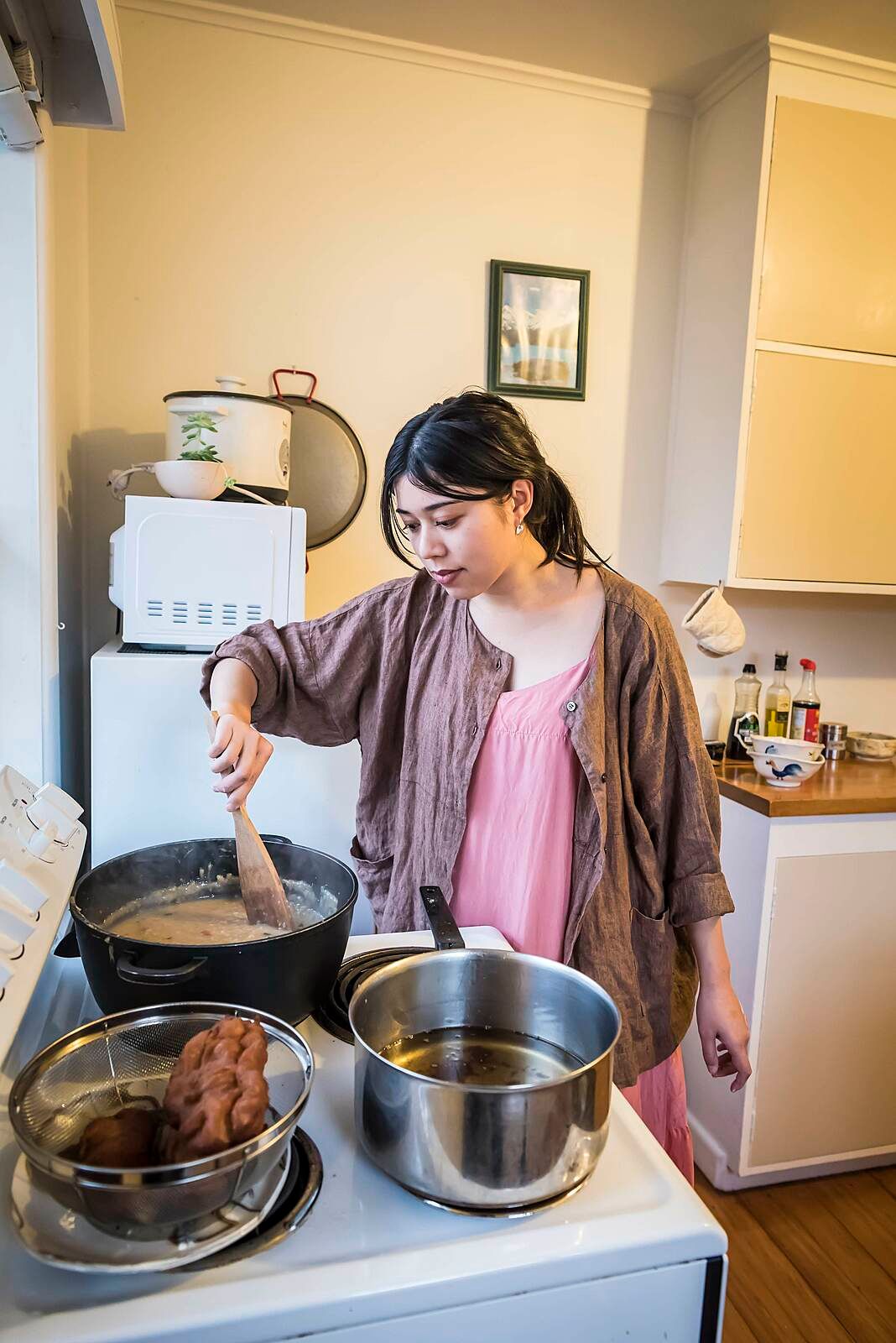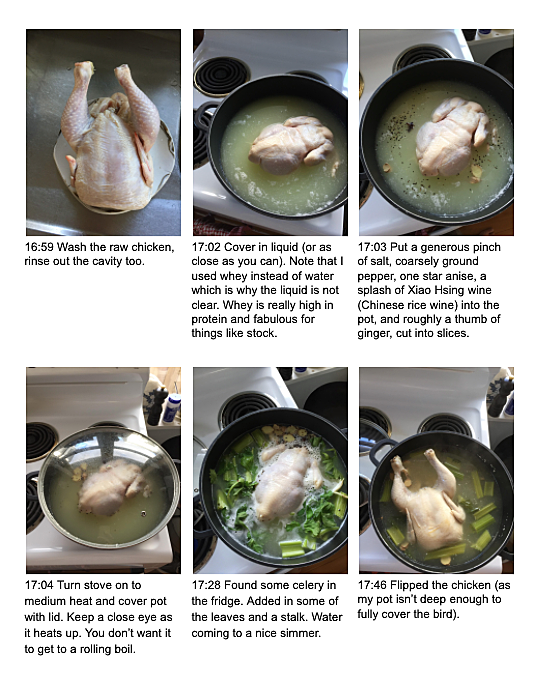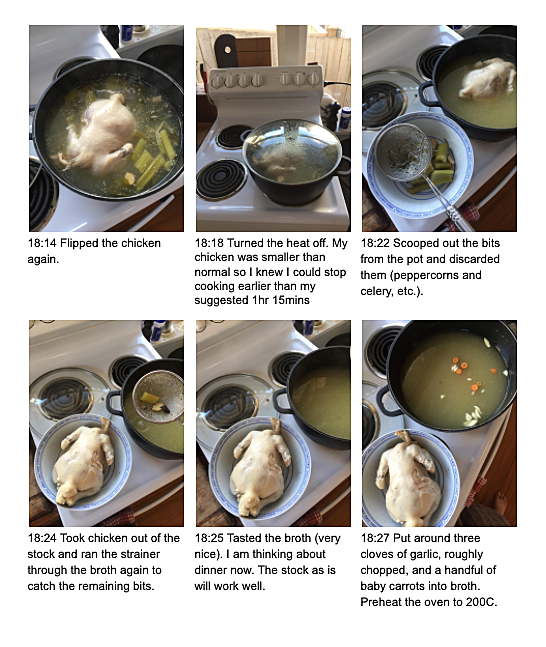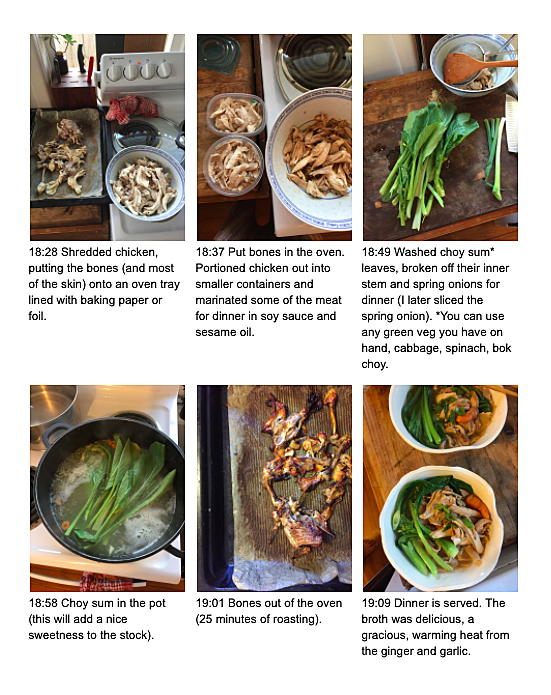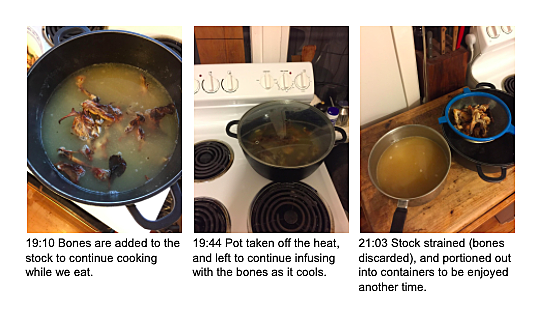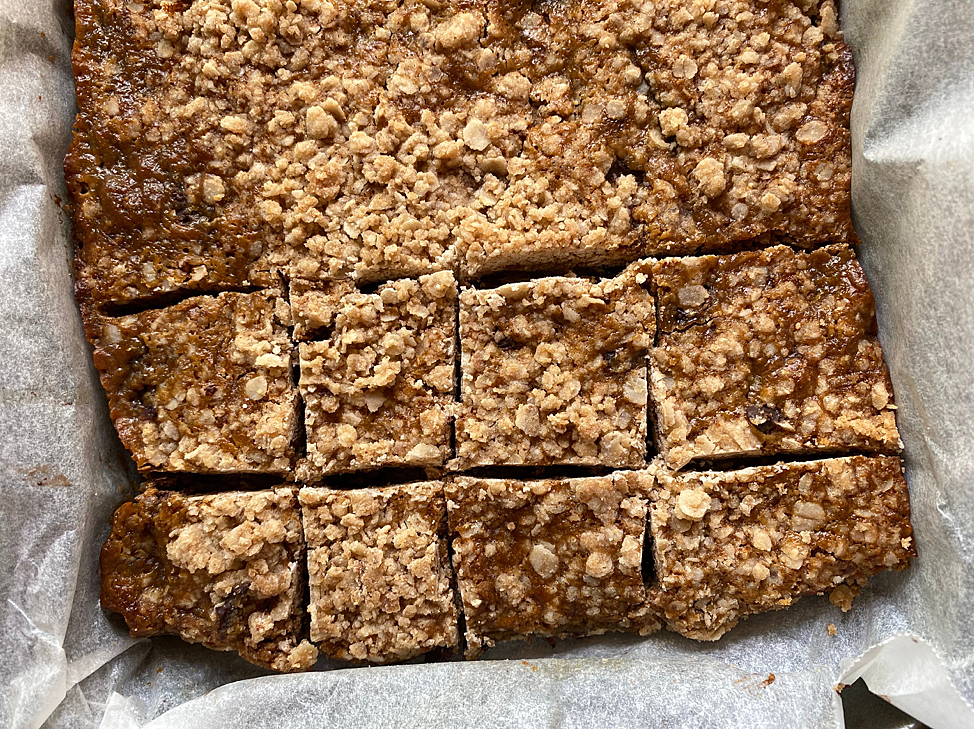Home Cooking
Food can transport us elsewhere, or bring us closer to home. Cooks Ruby White and Laura Vincent are invited to write about a dish they've made during lockdown.
The shared cooking in my flat kitchen has gotten out of hand. I live at the foot of Dominion Road where you can find ten kinds of dinners for ten dollars, but there is nowhere delicious that’s open right now. We can’t get takeout, and, relatively speaking, we have loads of time on our hands. Time makes our hands fidgety. Restless bank accounts make us act higher-class with our groceries. So far we’ve made flatbread, hand-pulled noodles, hoagies, labneh, vegetarian curries, sweet and sour pork, lasagne, brownies, muffins, dumplings, toasted sandwiches with four types of cheese, pizzas topped with artichokes.
I’ve been enjoying the challenge of being in the kitchen more frequently. I like cooking, but I usually don’t feel like I have the time to make something properly. I’ll wait until I’m at my hunger peak before I start prepping, at which point desperation sets in and dinner becomes half a carrot and microwaved rice.
Because there’s nowhere I feel obligated to be, I have hours to make dinner instead of minutes. Everybody online is making focaccia. I’ve been pickling and marinating ingredients, slow-cooking my sauces, leaving pots on simmer and actually defrosting my meat thoroughly. Soon enough, I’ll start on the bread trend.
I’m no chef though, I just have an appetite and an attention-deficit disorder (it’s best to keep my hands busy). I asked two cooks and foodies whose palates I genuinely trust, Ruby White and Laura Vincent, to reflect on a dish they’ve made over lockdown, and what their relationship to food is like at the moment.
– Vanessa Mei Crofskey
Ruby White, Unity Chicken
This story is about how to cook and eat chicken. Part of this process is to recognise that they are more than a miracle animal that lays eggs and has juicy thighs. The chicken's history tells a tale of the transition from nomadic human tribes to sedentary civilisations, the maturing of industrialised farming and capitalism. Chickens, and food at large, are intrinsic to our collective and personal histories and socioeconomic structures. They are central to what it means to be human.
There has been a recent refocusing and revaluing of the domestic space and home cooking as capitalist structures crack, sizzle and pop under the pressure of global pandemic. Yesterday I found myself drawing parallels between the lives and fates of battery hens and the hundreds of thousands of humans currently cooped up in our own homes… thank hell we can cook!
A whole chicken is a gift.
My eating routine is part of what defines and structures a day. Cooking is an introspective process for me and I find the emotional stability that comes with home cooking unparalleled. I think cooking, and eating what you cook, helps to keep the soul grounded. There’s enough science about the benefits of eating well on the mind and body to swallow you whole – but using your two hands, your five senses, is equally important.
So, chickens! They are available, affordable, pancultural and they come whole! A whole chicken is a gift. In my perspective it complements this shared global experience we as humans are collectively working through: this compounding sense of wholeness/oneness, and our recalibrated appreciation for the domestic.
I buy whole chickens for two reasons: it is more economical and you get all the bones (bones = flavour). I can appreciate that dealing with a whole bird is less time efficient, a common deterrent for many people. But, considering that we are currently in lockdown, for those of you with a chicken-sized pot, a working stove and some extra time up your sleeves, I’d say it is a worthwhile investment. Using everything that an ingredient has to offer is a holistic display of respect for the animal (or plant), the grower and the planet.
I think cooking, and eating what you cook, helps to keep the soul grounded.
I like to poach a chicken because it is easy, the taste of the chicken is pure and you have instant stock. In Chinese culture chickens are prized for their protein, fats and energy-rejuvenating properties. Some of you might be familiar with chicken essence, a traditional Chinese supplement. We love and value chicken broth so much it is given as a gift during Chinese New Year! A good chicken stock is full of natural umami and feels like the sun warming your body from the inside out. Chicken stock serves as the base for loads of curries, stews, soups. You can portion out the stock into smaller containers and freeze. This way your stock is always at the ready for when you might need it.
I adore using chicken stock to cook my rice; the grains become glossy from the protein and fat… it is such a treat. The caramelised bits of rice and chicken fat that catch on the bottom of the rice pot are really special.
Dinner tonight was noodles in chicken broth, served with blanched choy sum, baby carrots and shredded chicken. Plain, warming food has this romantic way of slowing down time, and returning me to a place of serenity in my mind.
Click here to skip to the recipe
Laura Vincent, on baking
We take food way too seriously. “So long to prepare, gone so quickly,” says Mum after dinner. She’s right. We eat, we start over. And yet – it is serious. Muscle memory passed down through generations. Your heritage, a briny marinade tenderising your skin. Each recipe a story, a world. You may, of course, want to eat your cornflakes in peace without pausing to consider social history or the assessing eyes of your ancestors. I’ve spent 13 years writing about food and aim to exist somewhere between this urgency and futility. But my relationship with food is pretty intense. Every time I cook dinner it feels like forever till I get to make it again. Recipes barge into my head: what about macaroni cheese with three kinds of pickles? Chocolate ice cream with molasses? I can see myself making it, I can taste it.
But with so little to anticipate, the tiny becomes enormous.
Last year I moved back home. “Call it a writer’s residency,” said Mum. I could also call it escaping the sinkhole of Wellington rent prices and bartender wages. When you live with your parents in a rural village, not much changes under lockdown. But with so little to anticipate, the tiny becomes enormous. Usually round 5pm a bag of chips is shared with a glass of whatever cheap wine is open. On Tuesday I was FaceTiming my best friends and missed out. What should have been a quickly forgotten inconvenience became a heavy boulder of injuriousness dragged around for several wounded hours before I told myself to shut up, they’re just chips, people are suffering. Even so, in the absence of anything exhilarating going on, it hit me hard. Tonight we had our neighbour’s homemade gin and the remains of a bag of chips that a mouse nibbled the bottom of. We kept them. Frugality, or skewed priorities? At least I got chips.
When you make food, you work with what your immediate context offers. In 2018: staff meals, instant mashed potatoes, and anything I could scrape together to blog about. In 2011 – before Instagram influencers, when food bloggers ruled PR mailing lists – I was invited to free dégustations. Right now I’m doing okay, between these extremes, because I’m living with my parents. Though lockdown has a shrinking effect on my brain, I still want to eat, create, and write about food, and I’m lucky I can.
When you write about food you’re going to exclude someone – they can’t afford it, they’re allergic, they’re not interested. All I can do is try to not be a dick – to share recipes and thoughts in a non-annoying way. My intention hasn’t changed. Baking might sound particularly trite and unnecessary during Covid-19. But man, when your days are small and repetitive, that sugar-jolt of cake almost tastes like the city surging around you, fingertips on your cheek, cracking up with a stranger in line for the bathroom at a house party. It’s also delicious.
This is a caramel slice I’ve made several times in lockdown. You can muck around with it depending on what ingredients you have, and if you cut it into inch-square pieces it feels like there’s heaps. The important thing is, it tastes so good: crunchy, rich and caramelly, in a chill, oaty way.
Click here to skip to the recipe
To poach a chook, cover it in cold water, bring the pot to a simmer and leave it to cook for about 1hr to 1hr 15mins. If your pot isn’t large enough to submerge it, just fill the pot, leaving about 5cms of space from the top. The chicken will cook fine, you might just want to flip it a couple of times, as I did. You can do other stuff at this time, just keep an eye on the pot. When poaching a chicken you don’t want rapid boiling, as this will make the meat tough. At the end the meat should just fall off the bone. After poaching you can shred the chicken, portion it out and freeze it as is, or marinate it in sesame oil and soy to be eaten with rice or noodles (as I do below). Toss it through pasta or add it to a salad… the combinations are endless. I’d say a whole chicken usually feeds about four to six people. To make the meat go further you can use it as a garnish and supplement the dish with an egg, tofu or veggies to go alongside your carb of choice.
The liquid you poached the chicken in makes a plain but delicious stock. To enhance the flavour you can add onions, carrots, garlic, peppercorns, ginger, star anise, salt, bay leaves, or any other aromatics while the chicken is cooking. After poaching, strip the chicken of all its meat and roast the bones until they’re charred and golden. Add all the bones to the original broth and bring it back to the boil. After 45 minutes to an hour, strain the stock, discarding everything that catches in the sieve. If you can cook it for longer then go for it. The longer the better!
Below is an analogue live-stream of me cooking chicken stock and dinner tonight. This is how I cook in the real world, thinking on the go, multitasking and using up what is in the fridge. This is not an overly prescriptive recipe: I want to leave this as open to you and your kitchen as possible. There is no one way to do something and you don’t need fancy ingredients or expensive equipment to feed yourself well.
Hygiene notes
● I would advise against leaving the chicken to cool in the stock. It’s best to take it out of the pot and set it aside to cool down for about 10 to 15 minutes. I used powder-free latex gloves to shred the chicken, but if the heat is burning your hands, use tongs or some forks. I prefer gloves because it’s faster and you can feel the bones.
● Once the chicken is portioned out into its containers, let it cool down with the lid resting on top for about 15 minutes. Store it in the fridge or straight into the freezer if you know you aren’t going to eat it within the next couple of days. When defrosting the meat, it’s best to try and do it in your fridge. Take it out the night before if possible.
● You will want to heat the stock up to boiling (100C) for any food you use it in.
Laura’s Coffee Caramel Slice (V)
Base
● 1/2 cup coconut oil, melted
● 3/4 cup rolled oats
● 1 and 3/4 cups plain flour
● 1 cup brown sugar
● 1/2 teaspoon baking powder
● 1/2 teaspoon baking soda
● pinch salt
Filling
● 1/2 cup tahini
● 1/2 cup golden syrup
● 1/2 cup canned coconut milk (the thick stuff at the top)
● 2 heaped teaspoons instant coffee powder
● a solid pinch of salt
● 1 cup dark chocolate roughly chopped into chunks
- Set your oven to 180C and line a brownie/baking tin (either around 20cm square or 27 × 17cm) with baking paper.
- Stir all the base ingredients together till it forms sandy crumbs. This doesn’t make a huge amount so try to resist eating it as you go, like I tend to, and it may need an extra spoonful of oil if it’s not coming together. Press 3/4 of the mixture evenly into the base of the baking tin, pushing it down with the back of a spoon, and set aside the rest.
- Bake the mixture in the tin for 10 minutes. Meanwhile, whisk together the tahini, golden syrup, coconut milk, coffee powder and salt. Have a little taste – it’s so good. Don’t worry if the coffee powder is still gritty, it will dissolve as it cooks.
- Once the 10 minutes is up, remove the base from the oven and sprinkle the chopped chocolate evenly over it. Carefully pour the caramel mixture over the top so it forms an even layer and the chocolate is mostly submerged. Finally, sprinkle over the remaining oat mixture.
- Bake for another 15 minutes, then allow to cool. Refrigerate for at least two hours, more if you have the patience, before slicing. It will hold its shape this way, and it tastes best cold.
Substitutions
● You can use margarine instead of coconut oil.
● If you have a food processor you can blend up oats to make flour out of them and replace some of the regular flour. You can also use self-raising flour and leave out the baking powder.
● You can use plain sugar, or it’s also really nice with the crunch of raw sugar.
● Instead of tahini you could try using peanut butter, although this will change the flavour.
● You can replace the golden syrup with maple syrup or honey.
● You can add sweetened condensed coconut milk and date paste to the mixture as well – add about a 1/4 of a cup and reduce the golden syrup by half.
● This recipe should work with soy milk or anything similar as a substitute for coconut milk.
● If you only have a little dark chocolate that’s okay! You can also use buttons or chips.
● You can leave out the coffee – or add more if you want a stronger flavour.

